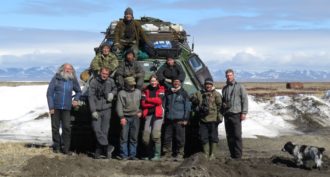Arctic is no longer the safe harbour for breeding shorebirds
News authored by Vojtěch Kubelka:
We have lived with the assumption that many migrating shorebirds can fly over large distances to breed in the Arctic to utilise lower nest predation among other advantages, e.g. plenty of food during the short Arctic summer, continuous daylight or lower parasite prevalence. However, a new study: Global pattern of nest predation is disrupted by climate change in shorebirds published in Science has discovered recent rapid increase in shorebird nest predation, especially in the Arctic, breaking the historical latitudinal gradient with the highest nest predation in the tropics. Higher nest predation rates are tightly associated with more pronounced global warming and climatic instability at the same locations. The climatically driven crash in abundances and cyclicity of lemmings at many Arctic places just prior the year 2000 probably play an important role in the recent pattern, because without lemmings, Arctic predators exploit more an alternative prey, e.g. shorebirds nest. Therefore sad but important message is that the Arctic nowadays represents an extensive ecological trap for migrating shorebirds from nest predation perspective.
The topic has already received broad media coverage, reaching probably more than 7 000 000 people, a few selected English links are listed here:
https://www.bbc.co.uk/news/science-environment-46124547
https://www.scientificamerican.com/article/climate-change-may-curtail-shorebirds-need-to-fly-north/
https://www.audubon.org/news/the-arctic-no-longer-safe-haven-breeding-shorebirds
https://sivtelegram.media/the-arctic-has-become-a-dangerous-place-for-birds/63476/
https://www.the-scientist.com/image-of-the-day
This achievement would not be possible without great researcher community investigating nests of shorebirds for decades and publishing their findings. International Wader Study Group has its unique and irreplaceable merit in the fact that our shorebirds enthusiastic group has been intensively working according to unified methodologies for decades all over the globe.
The current findings are worrying because on the top of well-known problems of shorebirds at stopover sites precipitating into the deterioration of adult survival, the same species are now squeezed by the low reproductive success too. Therefore it is not surprising that majority of shorebirds are already declining globally – out of 192 shorebirds with known species trend (remaining 53 species are classified with unknown trend), 110 species (57.3%) are declining, 60 species (31.2%) are stable and only 22 species (11.5%) were assigned as globally increasing, the situation is even worse for Arctic breeding shorebirds (data manually extracted from BirdLife International Data Zone: https://datazone.birdlife.org/species/search).
Nest predation is very dynamic in the Arctic, with a high inter-annual and inter-locality variation. I wish shorebirds to profit from low nest predation in the vast Arctic areas again and experts say that if coming winter is good, the year 2019 could be after a long time again a good lemming year at least in Scandinavia, but general average trend over last decades, unfortunately, suggests unfavourable future for shorebirds.
As shorebirds enthusiasts, we are responsible for the fate of shorebirds and conservation should matter to us. It is difficult to directly mitigate large-scale impacts of climate change, but every little helps – from one nest direct protection to set up large national reserves preventing habitat loss at staging areas or promoting international cooperation in shorebirds and their habitat conservation. As scientists, we should take our time to disseminate our results among conservationists and policymakers, as well as we should translate our finding for the wider public. Our work does not end by publication and our voices about shorebird problems must be heard, because general public awareness is the key for turning scientific knowledge into effective conservation. Shorebirds deserve our attention from the conservation perspective, especially now, during the era of rapid changes in the global environment. Let’s do our best to secure future for our admirable shorebirds.
Vojtěch Kubelka
Scientific Coordinator of the ÉLVONAL SHOREBIRD SCIENCE
https://elvonalshorebirds.com
Executive Committee member of International Wader Study Group

Field crew in front of the caterpillar vehicle (vězděchod) during Arctic shorebird fieldwork in Chukotka, Russia, ©V. Kubelka.
Featured image: Incubating Great Knot (Calidris tenuirostris) in the Golden Ridge, facing uncertain future, Chukotka, Russia, ©V. Kubelka.
